
Securing Your Sensitive Data: A Guide to Encrypting ZIP Files
In an age of constant connectivity, protecting your confidential information is more critical than ever. Whether it’s a collection of private documents or a sensitive business report, sending a ZIP file without a password can expose your data to risk. Fortunately, you don't need to be a security expert to solve this problem. This comprehensive overview, will show you how to effortlessly encrypt a ZIP file using Folder Lock, an intuitive and powerful tool that turns a complex task into a simple process.
Why File Encryption Is a Smart Move
Encrypting your ZIP files is one of the most effective ways to safeguard the privacy and security of your documents. In a world where data breaches are an everyday threat, this simple step can save you from significant trouble. Encrypted ZIP files are used across many industries and for countless reasons, including:
- Legal: Securing client contracts, non-disclosure agreements, and case files.
- Financial: Protecting tax returns, bank statements, and payment invoices.
- Medical: Ensuring the confidentiality of patient records and health histories.
- Business: Shielding strategic plans, marketing data, and sensitive HR information.
Whenever you need to keep information private, encrypting your ZIP file is a crucial and necessary measure.
The Right Tool for the Job: Online vs. Offline Encryption
When it comes to encrypting a ZIP file, you have two main options: using an online service or an offline application. The choice is clear when privacy is your top priority.
Online Encryption Services
These are web-based tools that promise quick and easy encryption.
- Pros: They are convenient and require no downloads. Many offer basic free services.
- Cons: This convenience comes at a significant cost to your privacy. To work, these services require you to upload your sensitive files to their servers, meaning your confidential data is in a third-party's cloud—a security risk you cannot control.
Offline Software
Offline tools are applications you install directly on your computer.
- Pros: They are far more secure, as your file never leaves your machine. They function without an internet connection, and you have complete control over the entire process.
- Cons: These robust tools typically come with a cost and require a one-time download and installation.
When the goal is to secure your most private files, trusting them to a random company's cloud is a major risk. For this reason, we will focus on using offline software.
Understanding ZIP File Passwords
Not all passwords for ZIP files serve the same purpose. It's important to know the difference.
- Open Passwords: An Open password controls who can open and view the content of a ZIP file. Without it, the file's contents are completely inaccessible. This is the most common and powerful form of protection, and it is what we will focus on in this guide.
- Permission Passwords: These passwords are used to manage specific permissions of a document, such as restricting printing, editing, or copying content.
Encrypting Your ZIP File with Folder Lock: A Simple, Secure Method
The easiest and most reliable way to encrypt a ZIP file is by using a dedicated security tool like Folder Lock. Its method is both simple and powerful, using a secure, virtual drive that handles all the encryption for you.
Pre-Requisite
You need to install Folder Lock application. However, If you have not installed it yet, You can read How to Download, Install, and Get Started with Folder Lock.
Method 1: The Fast Drag-and-Drop Method
This is the quickest way to get a single file into a secure container, a perfect solution when you're in a hurry.
Step 1: Launch Folder Lock and Your Locker
- Launch the Folder Lock application and enter your master password.
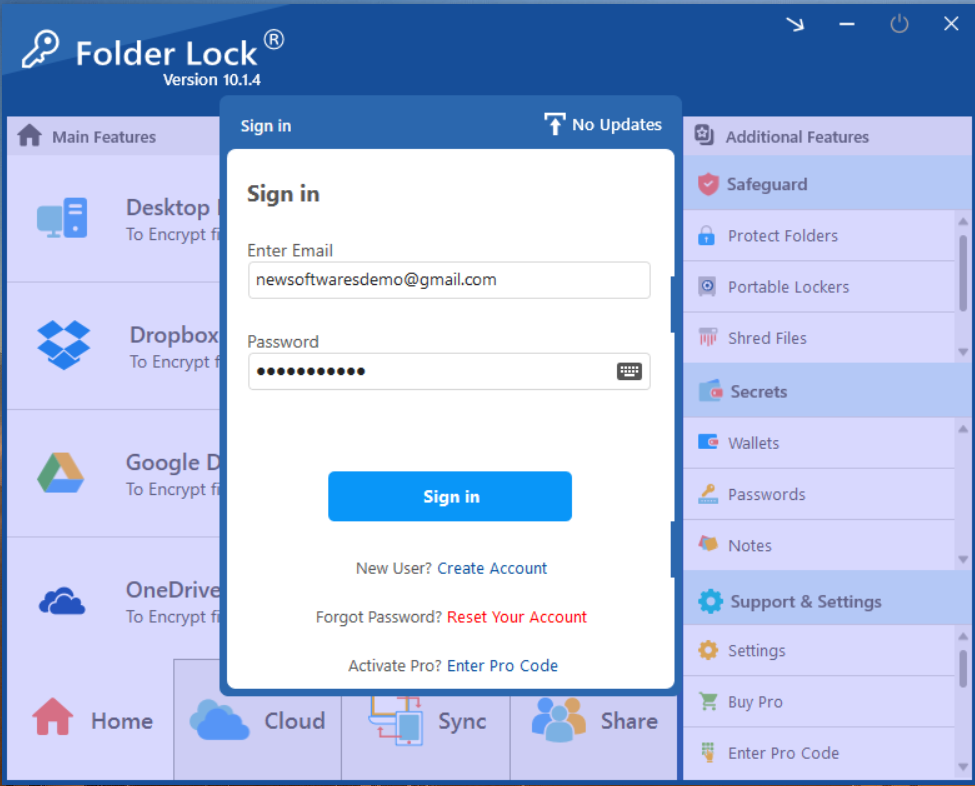
- On the main screen, locate the "Desktop Locker" section. If it's not open, click the "Open" button next to it. Your Desktop Locker will open in a new window, appearing just like a regular folder.
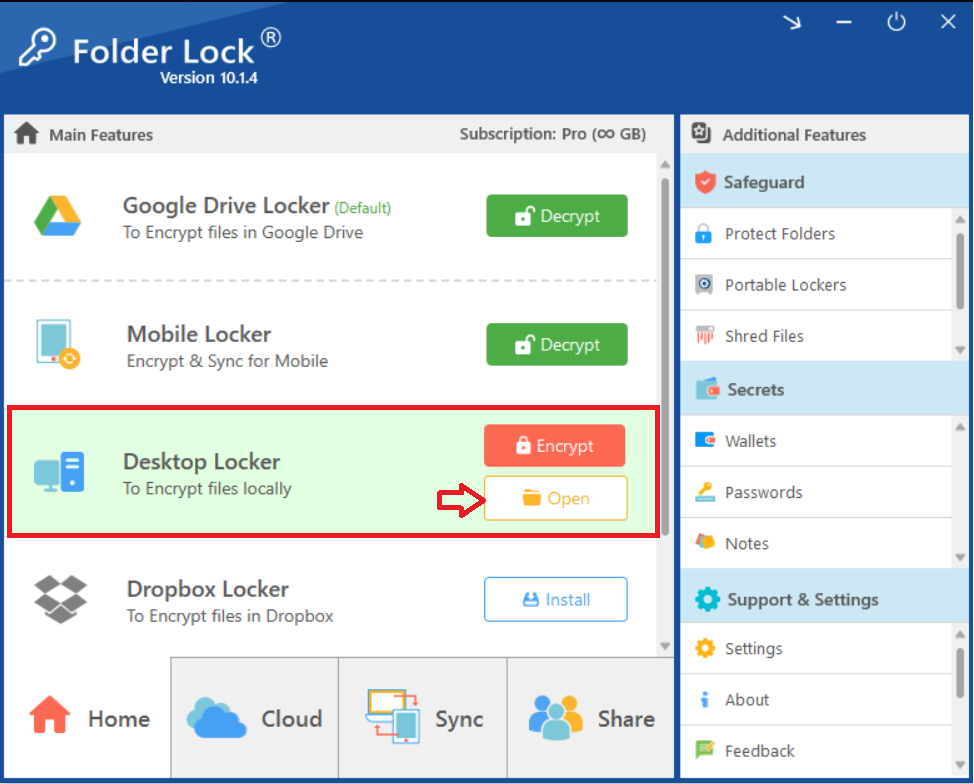
Step 2: Move Your ZIP File into the Locker
- Find the ZIP file on your computer that you want to encrypt.
- Drag the file and drop it directly into the opened Desktop Locker window. This action moves the file into the secure container.

Step 3: Encrypt Your Locker
- Once the ZIP file is inside, return to the main Folder Lock application window.
- Click the "Encrypt" button next to the Desktop Locker. This action will hide the locker and secure all files within it, including your ZIP file.

Alternate Method: Protecting via the Safeguard Tab
This is an indirect method that allows you to encrypt a file without moving it from its original location.
Step 1: Open Folder Lock
- Launch the Folder Lock application on your computer and log in.

Step 2: Select "Protect Folders" Under the Safeguard Tab
- Within the main interface, navigate to the "Safeguard" section.
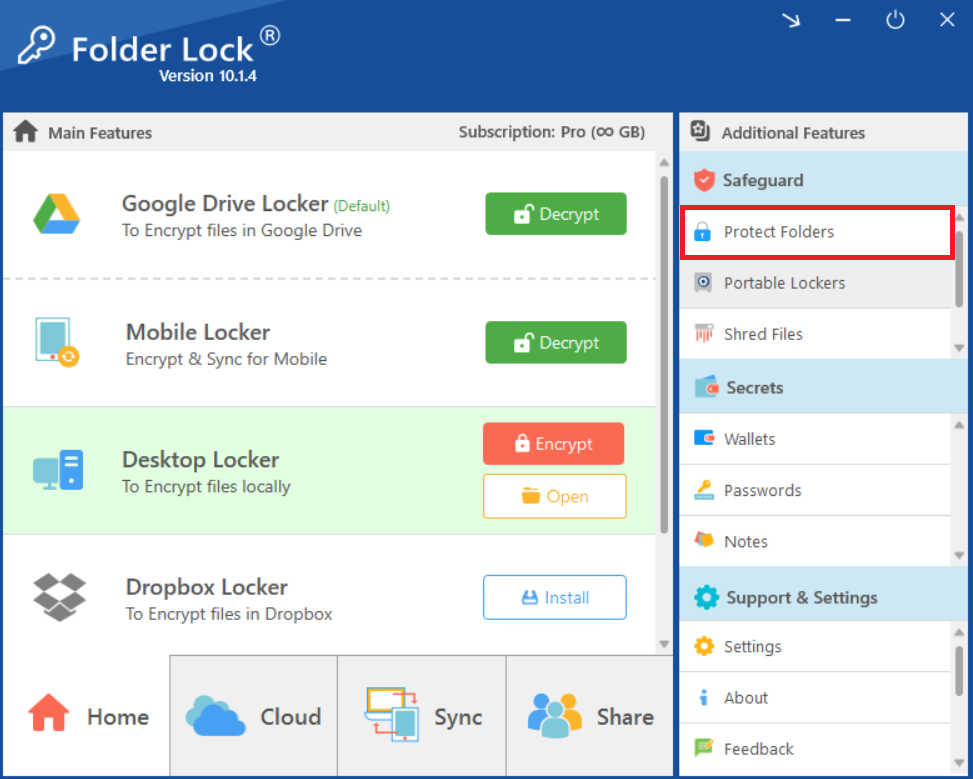
- Click on the "Protect Folders" tab. This will open the interface for hiding your items.
Step 3: Add Items to Encrypt
- In the "Protect Folders" view, click the "Add Items to Lock" button at the top of the screen.

- A dropdown menu will appear. You can choose to add individual "File(s)," "Folder(s)," or entire "Drive(s)" for protection. For encrypting your ZIP file, we will select "Add Files."

- Click on "Add File" to browse and select your ZIP file.
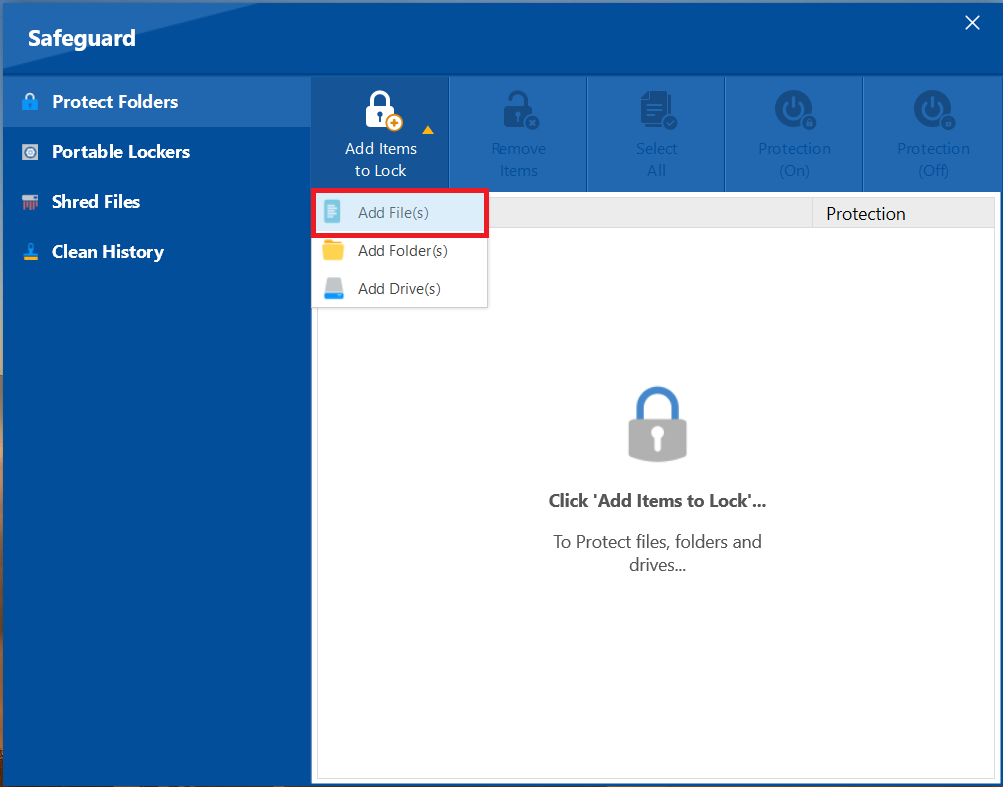
- After suceessful addition of your ZIP file, your encrypted ZIP file will appear as shown in below screenshot.
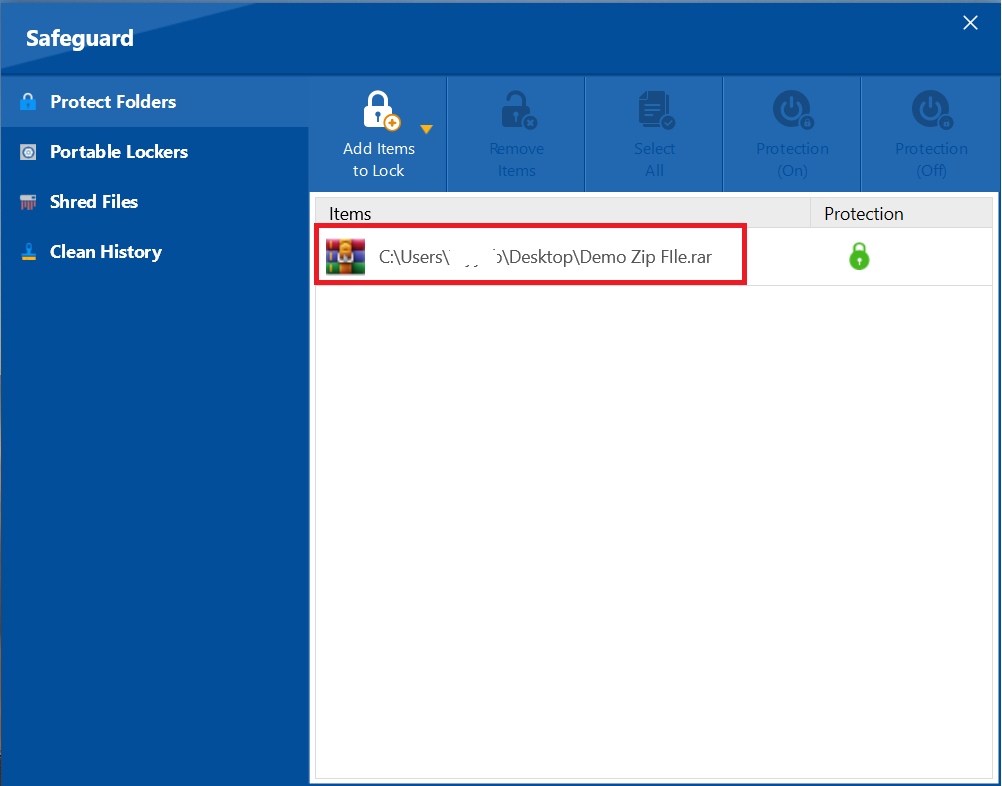
Step 4: Confirm Encryption Status
- A green lock icon under the "Protection" column indicates that the item has been successfully encrypted and is now hidden.
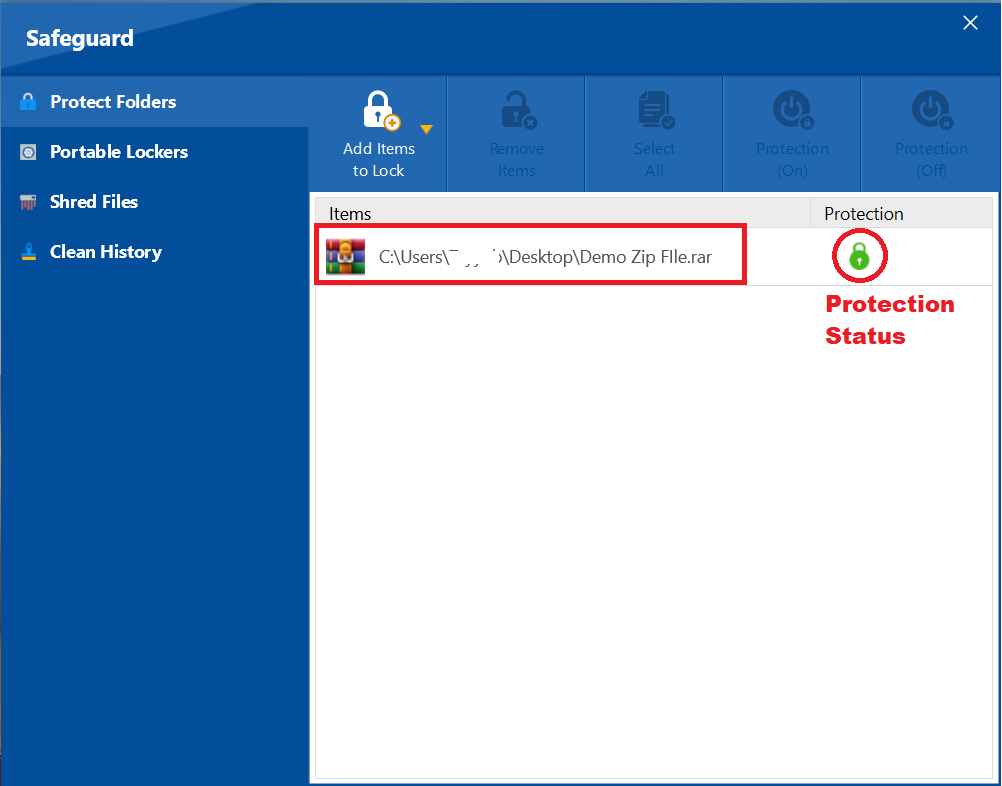
FAQs
Q: Can I open a ZIP file that was encrypted with Folder Lock using other software?
A: No. Files encrypted with Folder Lock use a proprietary, secure format. To ensure your data remains completely secure, the recipient must also have Folder Lock installed to open the file with the correct password.
Q: What is the difference between encrypting a ZIP file and simply password-protecting it with built-in tools?
A: Built-in password protection offered by some operating systems is often a weaker form of encryption that can be easily bypassed by common cracking tools. Folder Lock uses military-grade AES 256-bit encryption, providing a much higher level of security that is extremely difficult to breach.
Q: Will encrypting a large ZIP file take a long time?
A: No. Folder Lock's encryption engine is highly optimized for speed. While the time may vary depending on the file size, the process is designed to be fast and efficient, allowing you to secure even large archives quickly.
Q: Is it safe to send an encrypted ZIP file via email?
A: Yes. Since the file is already encrypted and password-protected, it is safe to send via email. Even if the email is intercepted, the data remains unreadable to anyone without the correct password and the Folder Lock application. You should always share the password through a separate, secure channel.
Q: What happens if I forget the password for my encrypted ZIP file?
A: Folder Lock has a password recovery feature that can help you regain access. However, for maximum security, it's always recommended to use a strong, memorable password and consider using a secure password manager to store it.
By following these straightforward methods, you have taken a crucial step in protecting your digital privacy. Folder Lock's simple yet powerful approach ensures that your confidential archives are no longer vulnerable. You can now manage and share your sensitive files with confidence, knowing they are protected by a robust encryption standard that gives you complete peace of mind.
